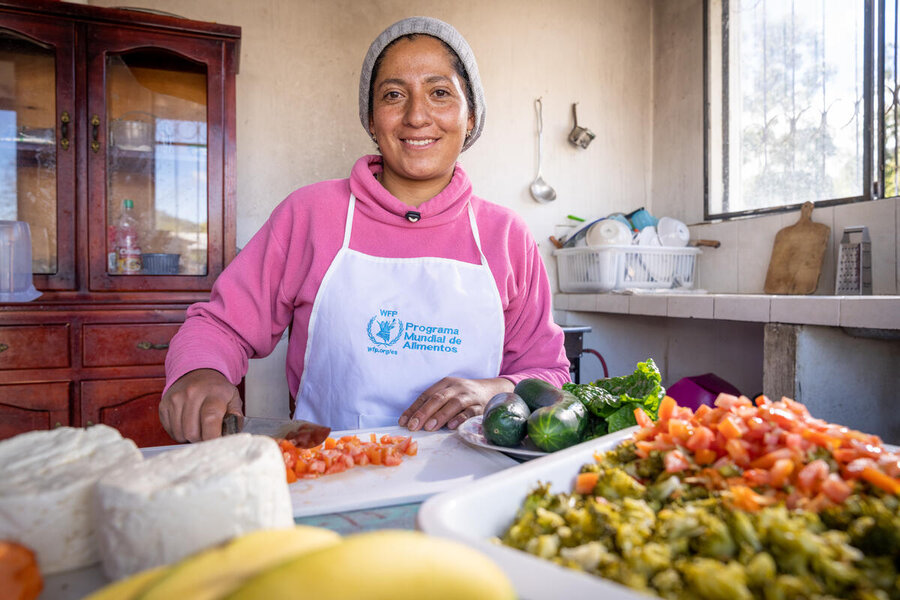How WFP’s home-grown school feeding takes nutrition to rural areas in Ecuador

Martha Solano takes a two-hour journey to work every morning. Her bus makes its way along winding mountain roads. As it heads into the heart of rural San Rafael, in Ecuador’s northeastern region of the province of Carchi, near the border with Colombia, there is plenty of time to reflect.
Solano is a teacher at Carlos Montúfar, a middle school supported by the World Food Programme (WFP), attended by 157 learners.
“Many of our students come to school hungry,” says Solano, with evident passion and concern. “Their parents leave early for work and the children often go without food until they return, late in the evening.”
In Ecuador, 21 percent of children aged 5 to 9, and 40 percent of those aged 10 to 14, arrive at school without having had a breakfast. In Carchi, chronic childhood malnutrition is at 23 percent.
WFP figures show 42 percent of students miss school due to illness or pain, often due to challenges in accessing nutritious foods, while only 50 percent of Ecuadorian families have access to nutritious foods. This is known to hinder learning and the all-round development of children as adults.

Last year, WFP, in coordination with the Government of Ecuador, launched a home-grown school meals programme to target rural areas with high levels of malnutrition and poverty.
The programme focuses on students in the early childhood and primary school stages of their schooling.
The home-grown element means schools in rural areas can buy fresh foods from local farmers. It allows children to eat nutritious meals cooked with ingredients procured locally, giving farmers a reliable source of income.
“In just two months, we’ve seen remarkable changes,” says Solano of the initiative. “Children who were once regularly ill are now thriving, and their academic performance has improved.”
This year, WFP aims to increase meal provision from 1,000 to 30,000 children across Ecuador's 17 provinces.
Traditional foods
Solano acknowledges that the project's success hinges on the collective efforts of community members such as teachers, parents, caregivers and local smallholder farmers – many of whose children she teaches.
“We've become a big family, all working together for the benefit of the children,” she says.
Ramiro Benavides, leader of the parents’ association at Carlos Montúfar is a smallholder-farmer.
“I cultivate a variety of crops, including short-cycle plants like tomatoes, peppers and onions, as well as long-cycle fruits such as avocados, mandarins and lemons,” he says.
“We’re fortunate to have fertile land here, and as parents, we actively contribute by providing food and preparing the meals.”

Such dedication is very the lifeblood of the collaborative spirit driving the initiative, ensuring the school community's wellbeing while bolstering smallholder farmers' livelihoods.
The programme tailors school-kitchen menus to regional differences, making the most of the abundance of locally sourced produce – and it aims to revive the consumption of traditional, ancestral foods through school meals.
Weekly menus are prominently displayed in the school to generate excitement within the community about upcoming meals. These menus are carefully planned through knowledge disseminated by WFP nutritionists to ensure the correct amounts of protein, carbohydrates and other essential nutrients are included in every meal.

The entire school community is informed and actively involved in this planning process.
“Diversifying students’ diets ensures they receive a wide array of essential nutrients vital for their physical and cognitive development, fostering healthy eating habits from an early age,” says WFP nutritionist, Fernanda Sandoval.
“One student approached me and said, ‘Teacher, you were right!’” Solano recalls with a smile. “I had shared with them the benefits of fava beans for memory, recounting how I always kept them nearby during my own study sessions.”
“Before, I didn’t like fava beans,” she recalls the student saying. “I didn’t want to eat them. I only got bad grades and didn’t understand anything. But I decided to try them before a test, and I did better.”
School feeding programmes offer significant benefits, serving as an excellent investment, with each dollar spent on meals generating an average of US$9 in economic return.
WFP programmes contribute to improved educational outcomes, with studies showing an average 9 percent increase in school attendance, while also addressing nutritional deficiencies, reducing the prevalence of anaemia by up to 20 percent.
Solano is determined to continue making a difference in the lives of her students. As she looks towards the future, her hope is simple: that the school meals programme will continue to nourish the hearts and minds of the next generation.
WFP's home-grown school feeding programme in Ecuador receives financial support from the private sector in Japan, the Church of Jesus Christ of Latter-day Saints, MasterCard, Lions Club Foundation and Fundación Favorita. It is implemented across the provinces of Carchi, Chimborazo, Santa Elena and Manabí. Moreover, WFP collaborates with Local Decentralized Governments, which also contribute to the financing, and the Ministry of Education, collectively striving to provide opportunities through proper nutrition.


